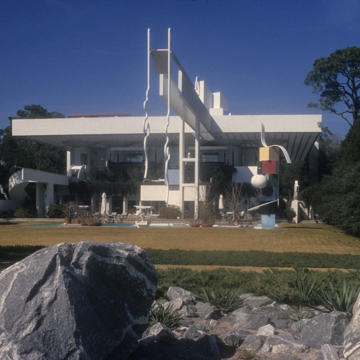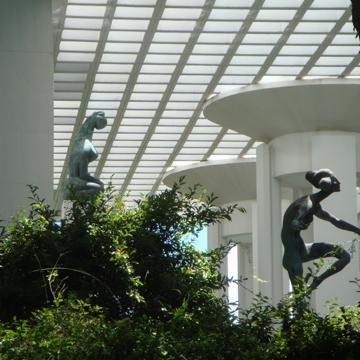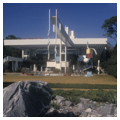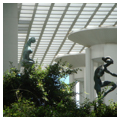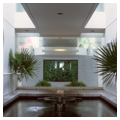You are here
John Portman Beach House
This coastal megastructure is a remarkable personal studio, museum, and house designed by architect John Portman as a weekend retreat where he could surround himself with art and books, and where he could create his own paintings, sculpture, and furniture designs. A controversial “beach house” whose high concrete space frame and 22,000 square feet of living space were initially considered out of scale with the more middle-class, traditionally styled, and suburban-scaled houses of the neighborhood, Portman’s work is a masterful blend of now-matured landscaping and modern construction. It is virtuoso architecture embodying the three essential elements of design: form, space, and light. In the end the house becomes both a manifestation of Gesamtkunstwerk (a total work of art) and a “house for an art lover.” The architectural and design ideas manifested here, and at Portman’s earlier residence in Atlanta (known as Entelechy I), found their way into his atrium hotels, convention centers, and other projects around the world.
The beach house is sheltered by a great sky-grid of concrete frame supported by twenty-four massive “exploding” (open) columns. The apertures of the space-frame roof cast a network of light and shadow across floors and terraces within, light squares that are open or more tightly closed, casting different light patterns depending on the time of day and angle of the sun. Overlapping interior spaces break down traditional barriers between interior and exterior and are organized around enclosed courtyards, open terraces, balconies and porches of various heights, and long corridors whose axes provide vistas and focal points of generally east-west orientation. Outriggers extend views beyond the beach to the ocean and horizon.
Furniture and decorative arts designed by Portman ornament living spaces and the surrounding landscape. Lounge chairs with canopies (the so-called Entelechy series “rickshaw chairs” of 1985), offer canopy-shaded comfort to occupants who can here replace business-suit formality with weekend informality. Abstract and figural sculpture is installed throughout the house, including bronze study maquettes of large-scale work commissioned for Portman buildings like the SunTrust Tower (originally #1 Peachtree Center) in Atlanta (1993) or at The Portman in San Francisco (1987). Portman’s own paintings adorn the walls. Like many modern architects, Portman found immediate artistic expression and an outlet for his creative energies and imagination in painting and sculpture.
The Sea Island Beach House is a Georgia landmark, an architectural masterpiece from the late twentieth century, and the most personal creation of Georgia’s most famous architect. Acting as his own client, Portman made Entelechy II a masterful coordination of landscape, architecture, design, and art. The Beach House literally stands above the ordinariness and derivative character of the traditional suburban residences that surround it.
References
Craig, Robert M., John Portman, and Aldo Castellano. John Portman: An Island on an Island. Milan: l'Arcaedizioni, 1997.
Writing Credits
If SAH Archipedia has been useful to you, please consider supporting it.
SAH Archipedia tells the story of the United States through its buildings, landscapes, and cities. This freely available resource empowers the public with authoritative knowledge that deepens their understanding and appreciation of the built environment. But the Society of Architectural Historians, which created SAH Archipedia with University of Virginia Press, needs your support to maintain the high-caliber research, writing, photography, cartography, editing, design, and programming that make SAH Archipedia a trusted online resource available to all who value the history of place, heritage tourism, and learning.




















